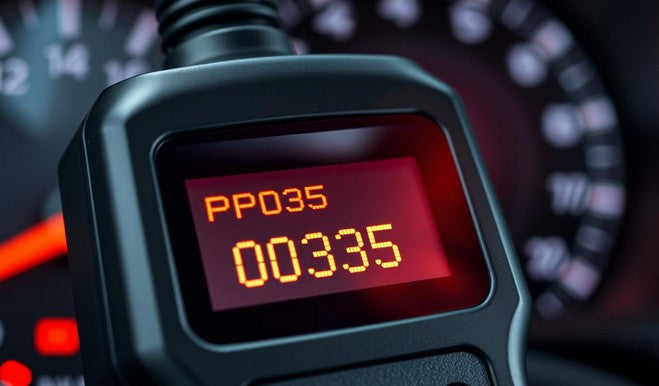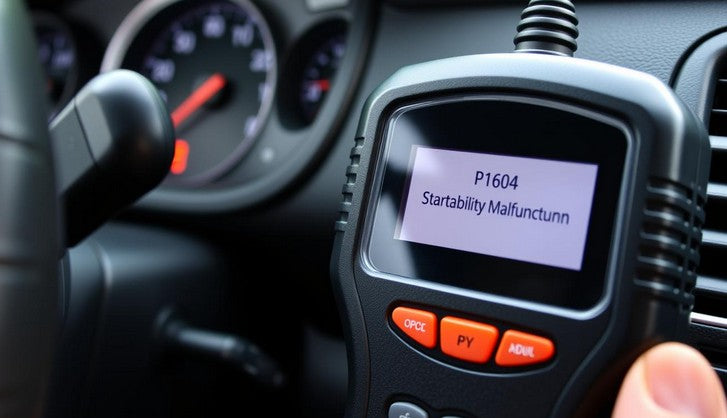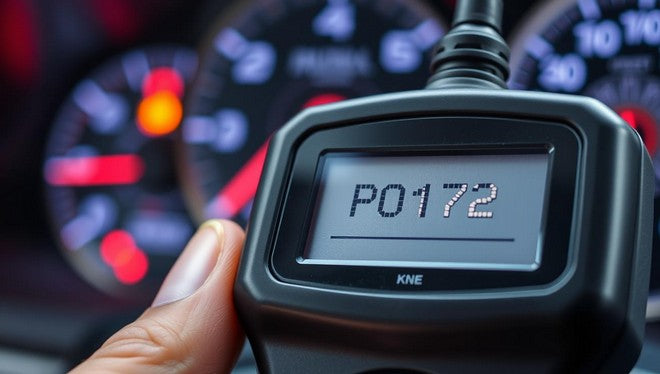When your vehicle's check engine light illuminates and a diagnostic scan reveals a P0335 code, you're dealing with a crankshaft position sensor circuit malfunction. This critical component helps your engine's computer determine the precise position and speed of the crankshaft, affecting everything from ignition timing to fuel delivery. Think of the crankshaft position sensor as the conductor in an orchestra – without its precise timing, your engine's performance falls into disarray. This comprehensive guide will walk you through understanding, diagnosing, and resolving this common but potentially serious issue.
What Does P0335 Circuit Malfunction Mean?
A typical OBD-II scanner displaying the P0335 code
The P0335 code specifically indicates that your vehicle's Engine Control Module (ECM) has detected an issue with the crankshaft position sensor circuit. This sensor generates signals as the crankshaft rotates, allowing the ECM to determine the position of the pistons and coordinate critical functions like ignition timing and fuel injection.
When the ECM receives irregular, intermittent, or no signal from this sensor, it triggers the P0335 code and illuminates the check engine light. Without accurate crankshaft position data, your engine cannot function properly, leading to various performance issues that we'll explore in the next section.
Common Symptoms of P0335 Circuit Malfunction
When your vehicle experiences a P0335 circuit malfunction, you may notice several telltale signs. Recognizing these symptoms early can help prevent further damage and expensive repairs.
Primary Symptoms
- Engine Starting Difficulties - Your vehicle may be hard to start or fail to start altogether as the ECM cannot determine crankshaft position.
- Unexpected Engine Stalling - The engine may suddenly shut off while driving or idling due to loss of crankshaft position data.
- Check Engine Light Illumination - The most obvious indicator, your dashboard's check engine light will activate when the P0335 code is triggered.
- Engine Misfires - Improper timing can cause cylinders to fire incorrectly, resulting in a rough-running engine.
Secondary Symptoms
- Poor Fuel Economy - Inefficient engine operation leads to increased fuel consumption.
- Reduced Engine Performance - You may notice sluggish acceleration and decreased power output.
- Erratic Idle - The engine may run roughly or at inconsistent RPMs when idling.
WARNING: If you experience sudden stalling while driving, this creates a serious safety hazard. Pull over safely as soon as possible and seek professional assistance.
Common Causes of P0335 Circuit Malfunction
Understanding the potential causes of a P0335 code is crucial for effective troubleshooting. Here are the most common issues that trigger this diagnostic trouble code:
Primary Causes
Faulty Crankshaft Position Sensor
The most common cause is a failed sensor. Over time, these sensors can deteriorate due to heat exposure, vibration, or internal electrical failures.
Damaged Wiring or Connectors
Frayed, broken, or corroded wiring in the sensor circuit can interrupt signal transmission. Loose connections at the sensor or ECM can also cause intermittent signal issues.
Damaged Reluctor Ring
The reluctor ring (also called a tone ring) has teeth that the sensor detects. If these teeth are damaged or the ring is misaligned, signal generation will be compromised.
Secondary Causes
Timing Belt or Chain Issues
A worn or misaligned timing belt/chain can affect the relationship between the crankshaft and camshaft, potentially triggering the P0335 code.
ECM Problems
Though less common, the Engine Control Module itself may have internal faults that prevent proper processing of crankshaft position signals.
Electromagnetic Interference
In rare cases, aftermarket components or damaged shielding can create interference that disrupts the crankshaft position sensor signal.
In most vehicles, the crankshaft position sensor is located near the crankshaft pulley, flywheel, or within the timing cover. Its exact position varies by make and model.
Diagnostic Steps for P0335 Circuit Malfunction
Follow this systematic approach to diagnose the root cause of your P0335 code. These steps progress from simple visual inspections to more technical testing procedures.
-
Verify the Code with an OBD-II Scanner
Connect an OBD-II scanner to confirm the P0335 code is present. Check for any additional codes that might be related or provide further diagnostic clues. -
Inspect the Sensor and Wiring Visually
Locate the crankshaft position sensor (refer to your vehicle's service manual) and examine it for physical damage. Check the wiring harness and connector for signs of wear, damage, or oil contamination. -
Test the Sensor Connector for Power and Ground
With the ignition on, use a multimeter to verify that the sensor is receiving proper voltage (typically 5V or 12V depending on the vehicle) and has a good ground connection. -
Check Sensor Resistance
Disconnect the sensor and use a multimeter to measure its resistance. Compare your readings with the manufacturer's specifications in your service manual. -
Inspect the Reluctor Ring
If accessible, examine the reluctor ring for damaged or missing teeth. This may require removing components for proper access. -
Test Signal Output
Using an oscilloscope or advanced scanner with live data capabilities, check if the sensor is producing the proper waveform pattern while the engine is cranking.
-
Check for Technical Service Bulletins (TSBs)
Research if your vehicle manufacturer has issued any TSBs related to P0335 codes for your specific make, model, and year.
Typical crankshaft position sensor circuit diagram
WARNING: Always disconnect the battery before performing electrical tests or replacing components to avoid short circuits or electrical shock.
Solutions for P0335 Circuit Malfunction
After diagnosing the specific cause of your P0335 code, you can proceed with the appropriate repair. Here are the most common solutions based on the diagnostic findings:
Replacing the Crankshaft Position Sensor
If testing indicates a faulty sensor, replacement is necessary. This is the most common fix for P0335 codes.
DIY Replacement Steps:
- Locate the sensor (typically near the crankshaft pulley or flywheel)
- Disconnect the vehicle's battery
- Unplug the electrical connector from the sensor
- Remove the mounting bolt(s) securing the sensor
- Extract the old sensor carefully
- Install the new sensor (apply a light coat of oil to the O-ring if present)
- Secure the mounting bolt(s) to proper torque specifications
- Reconnect the electrical connector
- Reconnect the battery
- Clear the code with an OBD-II scanner
- Test drive to verify the fix
New (left) vs. worn (right) crankshaft position sensor
Always purchase the correct sensor for your specific vehicle make, model, and engine. Using an incorrect sensor can cause continued problems.
Repairing Wiring Issues
If the diagnosis reveals damaged wiring or connectors, repairs are necessary to restore proper circuit function.
Wiring Repair Steps:
- Identify the damaged section of wiring
- Disconnect the battery
- Repair broken wires using appropriate gauge wire and weatherproof connectors
- Clean corroded connectors with electrical contact cleaner
- Apply dielectric grease to connections to prevent future corrosion
- Secure loose wiring with appropriate clips or ties
- Reconnect the battery
- Clear the code and test
WARNING: Improper wiring repairs can lead to short circuits, which may damage expensive components like the ECM. If you're unsure about electrical repairs, consult a professional.
Addressing Reluctor Ring Issues
If the reluctor ring is damaged, it will need to be replaced. This is a more complex repair that may require significant disassembly.
Reluctor ring replacement often requires specialized tools and extensive mechanical knowledge. This repair is typically best left to professional mechanics unless you have advanced automotive repair experience.
Timing Belt/Chain Replacement
If timing components are causing the issue, a complete timing belt or chain service may be necessary.
WARNING: Incorrect timing belt/chain installation can cause catastrophic engine damage. This repair requires precise alignment and specialized tools.
Prevention Tips for P0335 Circuit Issues
Preventing future P0335 circuit malfunctions can save you time, money, and frustration. Here are key maintenance practices to help avoid this issue:
Regular Electrical System Maintenance
Periodically inspect sensor connections and wiring harnesses for signs of wear, damage, or oil contamination. Clean connections and apply dielectric grease to prevent corrosion.
Timely Timing Belt/Chain Service
Follow manufacturer recommendations for timing belt or chain replacement intervals. Worn timing components can affect sensor operation and trigger P0335 codes.
Address Oil Leaks Promptly
Oil contamination can damage sensor components and wiring. Fix oil leaks quickly to protect the crankshaft position sensor circuit from exposure.
"An ounce of prevention is worth a pound of cure. Regular maintenance checks of your vehicle's electrical systems can catch potential issues before they trigger warning lights or cause performance problems."
- Experienced Automotive Technician
When to Seek Professional Help
While many P0335 issues can be addressed by DIY-minded vehicle owners, certain situations call for professional assistance:
- Complex Diagnostics - If basic testing doesn't reveal the cause, advanced diagnostic equipment may be needed.
- Intermittent Issues - Problems that come and go can be particularly challenging to diagnose without professional tools.
- Internal Engine Work - If the reluctor ring needs replacement and is located inside the engine, professional service is recommended.
- Multiple Related Codes - When P0335 appears alongside other codes, it may indicate a more complex issue.
- After Failed DIY Attempts - If you've replaced the sensor but the code returns, seek professional diagnosis.
Need Help With Your P0335 Circuit Malfunction?
Our network of certified mechanics specializes in diagnosing and repairing engine sensor issues. Get a free estimate for your vehicle repair today.
Frequently Asked Questions About P0335 Circuit Malfunction
Can I drive my vehicle with a P0335 code?
It's not recommended to drive with an active P0335 code. The vehicle may stall unexpectedly, creating a safety hazard. Additionally, continued operation could cause damage to other engine components due to improper timing.
How much does it cost to fix a P0335 circuit malfunction?
Repair costs vary depending on the cause and your vehicle make/model. A typical crankshaft position sensor replacement costs between $120-$300 including parts and labor. Wiring repairs may cost $100-$250, while more complex issues involving timing components or internal engine work can range from $500-$1,500+.
Will a P0335 code clear itself?
No, a P0335 code typically will not clear itself. Even if the problem appears to resolve temporarily, the code will remain stored in the ECM until cleared with a scanner. More importantly, intermittent operation suggests an underlying issue that should be addressed.
Which vehicles commonly experience P0335 issues?
While any vehicle can develop a P0335 code, certain models have higher reported incidents. These include various Chevrolet models (particularly the Silverado 1500), Toyota Camry and Corolla, Nissan Altima and Frontier, and the Audi A4. However, the issue can affect any vehicle with a crankshaft position sensor.
Can a bad battery cause a P0335 code?
While a bad battery typically won't directly cause a P0335 code, low voltage conditions can affect sensor operation and signal quality. If your battery is weak or failing, it could contribute to erratic sensor readings that might trigger the code. Always ensure your electrical system is functioning properly as part of your diagnosis.
Related Post:
Conclusion
The P0335 circuit malfunction code, while concerning, is often resolvable with proper diagnosis and repair. By understanding the symptoms, causes, and solutions outlined in this guide, you can approach this issue methodically and confidently. Whether you choose to tackle the repair yourself or seek professional assistance, addressing the problem promptly will help prevent further damage and keep your vehicle running smoothly.
Remember that the crankshaft position sensor plays a critical role in your engine's operation – it's the conductor that keeps all components working in harmony. With proper maintenance and timely repairs, you can ensure this vital system continues to perform reliably for years to come.




Leave a comment
This site is protected by hCaptcha and the hCaptcha Privacy Policy and Terms of Service apply.